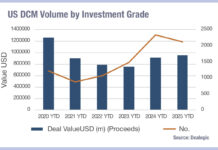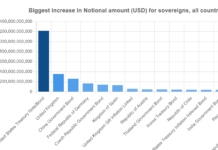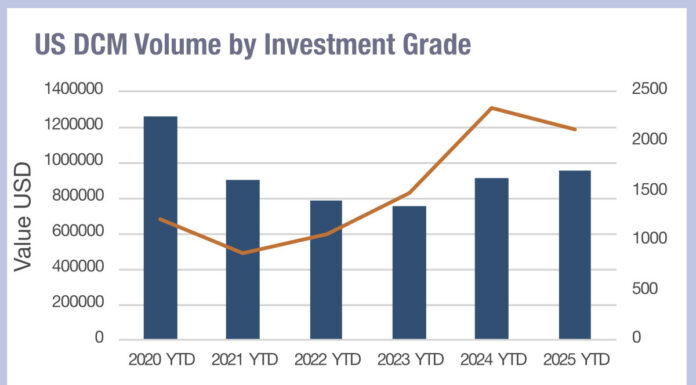The US Treasury’s need to increase debt issuance, beyond market expectations, has had several effects. Firstly there was a ratings downgrade of the USA by Fitch on 1 August; this was then was followed by a market sell-off.

“The swift sell-off in US rates markets last week caught investors off-guard,” wrote Solita Marcelli, global wealth management (GWM) chief investment officer, Americas, at UBS, in a research note dated 7 August. “The 10-year and 30-year yields moved 23–30 basis points higher to 4.2% and 4.34%, respectively, both a stone’s throw away from their 4.34% and 4.39% cycle highs.
However, the real surprise came in the shape of the yield curve. Over the last several years, rising interest rates have been accompanied by a flattening yield curve. Whether the drivers that pushed yields up were higher inflation or greater-than-anticipated growth, the brunt of rising rates have been in the short end of the curve as markets recalibrated the potential for rate hikes and the Federal Reserve’s terminal rate. As we reach the end of this cycle, however, those incremental moves by the Fed are having less of an impact on short-end interest rates.”

Kevin McPartland, head of research for market structure & technology at Coalition Greenwich, observed that average daily notional volume (ADNV) of US Treasuries traded after the downgrade surpassed the ADNV after S&P’s downgrade the week of 10 August 2011 however the size of the market and situation are quite different. “The total debt outstanding for the US today is roughly double what it was in 2011,” he notes. “Therefore, a much lower percentage of the total market turned over as a result of the downgrade. Second, the current record volume day for the market was back in March, following SVB’s collapse, coming in just under $1.4 trillion traded.
And lastly, the MOVE Index [which tracks volatility] actually declined slightly the day of and the day after Fitch’s downgrade, while it spiked notably back in 2011 … the data does suggest that US Treasury traders were largely unphased.” On 2 August 2023, the US Department of the Treasury had announced it was offering US$103 billion of Treasury securities to refund approximately US$84 billion of privately-held Treasury notes and bonds maturing on August 15, 2023, raising new cash from private investors of approximately US$19 billion.
In a statement accompanying the announcement, assistant secretary for financial markets, Josh Frost said, “Based on projected intermediate- to long-term borrowing needs, Treasury intends to gradually increase coupon auction sizes beginning with the August to October 2023 quarter. While these changes will make substantial progress towards aligning auction sizes with intermediate- to long-term borrowing needs, further gradual increases will likely be necessary in future quarters.
The scale of these increases will depend on a variety of factors, including the evolution of the fiscal outlook and the pace and duration of future System Open Market Account (SOMA) redemptions.” SOMA is the account managed by the Federal Reserve Bank holding assets it has acquired in the market, for example via quantitative easing. Morgan Stanley analysts then pick up the story; “Before markets could turn attention squarely to the looming NY afternoon bond auction, Treasury announced its third round of increases in T-bill auction sizes. Treasury increased the size of the 13-week bill auction by US$2bn, the 26-week bill auction by US$2bn, and the six-week cash management bill auction by US$5bn. Treasury’s end-September Treasury General Account (TGA) [which it uses to manage day-to-day activity and cashflow] estimate of US$650bn is US$218bn above the current TGA cash balance (8/9) which has fallen notably since late July.
Thus far, outright yield levels have attracted non money market fund (MMF) market participants to the increased T-bill supply, with T-bills held by primary dealers at US$54.8bn in the week ended 2 August, the lowest since 7 June.” The market struggled to absorb the T-bill auction size which MS reported was 10% larger than the prior new issues in the same week, and subsequently the market began selling bonds.
Writing on 9 August, JP Morgan analysts ventured, “One of the factors that potentially played a role in last week’s sell-off in bond markets was the Treasury’s financing estimates, which was larger than markets expected, and quarterly refunding announcement.”
Although these were not hugely out of line with expectations, they noted that a considerable increase in supply next year was highlighted by this announcement. “In practice the bulk of the funding of the deficit in 2023 has come via shorter-dated T-bill issuance rather than longer-dated bond issuance,” they observed. “For 2024, our US rates strategists expect the financing of the deficit to shift primarily to longer-dated bond issuance.”
©Markets Media Europe 2023
©Markets Media Europe 2025














